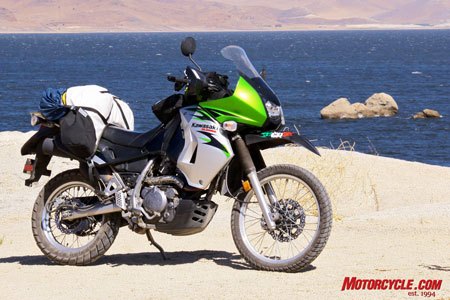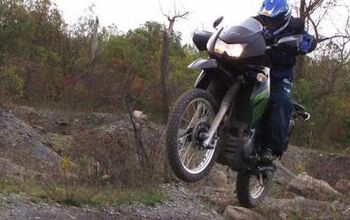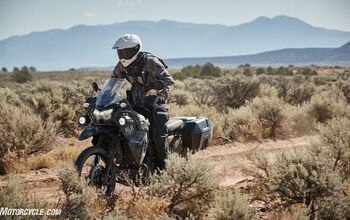Kawasaki KLR650 Project Bike: Part 6
For those riders less than excited about adding extra pounds to your D-P, off-road or street bike just to carry your tent to the trailhead in aluminum boxes, here’s a soft-sided alternative that’s portable, light and costs a lot less as well.
While stripping down our Project KLR to install the suspension and exhaust modifications you’ll read about in a future installment, we took the opportunity to test out a soft-sided rackless pannier system that’s easy to install and easy to remove as well. Oregon-based, Giant Loop Industries makes motorcycling luggage (one big bag, really) designed for abusive use on adventure bikes with one primary goal: To be as low and tight as possible to the bike for greater stability and control. A bag that hugs your motorcycle, much like you hug the road.
Designed like a huge stuffed horseshoe, the Great Basin is GL’s biggest bag in their line, with a capacity of 55 liters – nearly the capacity of a Goldwing’s trunk. Simply toss the loaded bag over the saddle of your bike, and use the sewn-in straps to cinch it down. And it removes easily, too, making load-out a breeze. Just unlash five straps and toss it over your shoulder like a cowboy does his saddle and walk away.
Beneath the tarpaulin canvas shell is space for four specially contoured stuff sacks (provided), two per side, plus two Nalgene/MSR-sized waterbottle holders sewn to the interior of the bag, and a center section that’s similar to a tank or tail bag but is sewn into the bag and not removable.
Loading the bag takes some getting used to, but the fully loaded package is tightly bound and designed not to shift around while tossing the motorcycle side to side. For my first attempt at loading the Great Basin saddlebag, I hucked it over the back of the couch to mimic the shape of a motorcycle, but I migrated it to the floor where I could lay it flat an load it unevenly – side by side – without fighting gravity’s pull off the couch toward the floor .
Balance is key and each “half” of the bag holds one of the black trapezoidal shaped sacks (designed to fit in the lower leg of the bag) beneath the yellow traditional roll-shaped stuff sack. Stuff your heavier items in the black bags for the lowest center of gravity; pack your lighter and softer items like a sleeping bag or clothing in the yellow bags.
Unfortunately, any items placed inside the black bags are difficult to access trailside. For those often-necessary items, there’s a separate zippered cube in the middle of the horseshoe (inside the bag), intended to mount centerline with the bike.
With all seven sections loaded, the entire unit can then be zippered shut. The seam-sealed waterproof, double-pull YKK zippers help keep the weather outside the bag.
Inside the bag, but outside of the stuff sacks contained within, there’s still enough room for a few more soft items like a jacket liner or a pair of gloves, but the overall U shape prevents you – like almost any moto-luggage – from storing tent poles inside the bag, however. Strap those to the lashing loops sewn to the bags exterior.
Loaded and ready, toss the bag onto your saddle with the zipper facing toward the rear of the bike, attach the two lower forward-pulling cinch straps to the passenger-peg mounts or frame rails, and the three rearward-stabilizing lashing straps to your bike’s rear rack, passenger grab rails or seat stays. I used the left and right lashes to pull from the outside edges of the KLR’s rear rack and the center lash for holding my tent poles tight to the rear of the saddlebag.
The bag’s design will accommodate many makes of motorcycle, but doesn’t fit well on the rack portion of a stock KLR, so you sacrifice the passenger saddle space with this back. A positive there is that you can still use your rack for a trunk box, or hauling wood if the need arises. Carrying too much weight that far rearward negatively affects a bikes handling anyway; no great loss in my opinion.
Two additional 1.0-in. Ballistic Cordura and Nylike straps cross the outside of the bag parallel to the ground for compressing the internal load as tight as possible, further stabilizing the overall load.
The bag is available in two colors, a gray on white as seen in our photos, and a black with subtle black branding for a sharp looking bag.
The Great Basin sells for an MSRP of $399, which is a little steep compared to other saddlebag systems, but the shape and compactness of the Giant Loop bags might be well worth the extra dollars.
Comparably, an expandable 50-liter RKA-luggage set of traditional saddlebags, in an array of colors, will run you about $250. A set of Wolfman expedition saddlebags and a expedition dry duffel (sold separately) with slightly more carrying capacity (68 total liters) will run you about $275, but they surely don’t perform as one tight unit on the bike when times get tough, but I’ve never used their product. They also produce a patent-pending expedition rear bag ($174.99) that also hovers over the saddle in a similar manner to the Great Basin, but it looks rather tall in the photos. Again, that’s speculation.
Lastly, RevPack makes an excursion pack ($209.95) with 71 liters of capacity and is shaped similar to the Wolfman bag, tall and capacious. Don’t know much about it, but again, I think the contouring Great Basin bag is the bag you want on the trail. Good luck out there!
Related Reading
Kawasaki KLR650 Project Bike: Part 1
Kawasaki KLR650 Project Bike: Part 2
Kawasaki KLR650 Project Bike: Part 3
Kawasaki KLR650 Project Bike: Part 4
Kawasaki KLR650 Project Bike: Part 5
Kawasaki KLR650 Project Bike: Part 7
Kawasaki KLR650 Project Bike: Part 8
More by Alfonse Palaima































Comments
Join the conversation